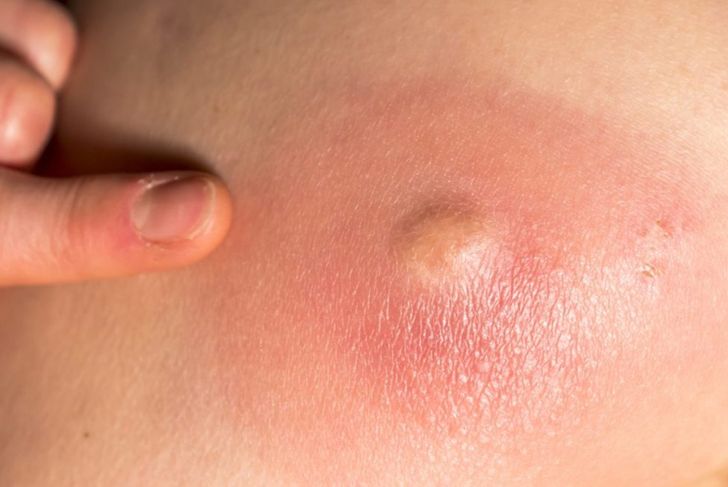The term “blood poisoning” can be misleading, as the condition has nothing to do with actual poison. Instead, the name describes a common condition where bacteria are present in the bloodstream. Medically, blood poisoning can advance to sepsis, which can result in death. To prevent fatality, doctors must diagnose and treat sepsis quickly. In most cases, the initial infection starts in another part of the body and travels to the bloodstream. Blood poisoning may develop due to an insect bite, urinary tract infection, dental extraction, open wound, or pneumonia.
Chills
You may begin to experience chills after blood poisoning. Bacteria are tricking your body into thinking you are cold and need to warm up. This triggers shivering as your body attempts to generate heat and raise your body temperature. Your muscles are also contracting and releasing when your body is in this state.
Moderate or High Fever
The normal body temperature for humans is 97.6 to 99.6 degrees Fahrenheit. If you have a temperature reading above this range, you have a fever. As with chills and fatigue, fever is a symptom of many different illnesses. It is your body’s natural reaction against infections. Either your immune system or the bacteria that invade your body releases substances called pyrogens. These substances generate fever by triggering your body to create more heat and lose less. This reaction causes the release of your white blood cells to fight infection.
Rapid Breathing
If you begin to have difficulty breathing, it is likely your blood poisoning condition is entering a state of sepsis. This is the second stage of blood poisoning and may indicate that your organs are starting to malfunction. In most cases, a person with blood poisoning is taking more than 22 breaths per minute.
Weakness
Tiredness or fatigue could be symptoms of a wide range of illnesses. When the body starts to feel weakness, hormones called cytokines send signals to cells, alerting them that something is wrong. They tell the body to preserve energy. The kind of fatigue that is usually a sign of blood poisoning is not the typical tiredness at the end of a work day or after performing house chores. Rather, if basic movements or simple tasks tend to exhaust you, you may need to monitor your symptoms.
Increased Heart Rate
People with blood poisoning may experience a faster-than-normal heart rate while at rest. This condition is called tachycardia. Electric signals that move across heart tissues control your heart rate, which is typically about 60-100 beats a minute when you are not active. If you do not treat tachycardia, it can lead to more serious issues like heart failure or stroke.
Paleness of the Face
Although paleness affects your entire body, it is most visible in the face, nails, and eyes. Unless you can see it inside the mouth, the lining of the eyes, tongue, lips, and palms, it is not usually serious enough to require medical attention. Paleness occurs when you lose color from your mucous membranes. In people with darker skin, it is only detectable in the linings of the eyes and mouth. Doctors make a diagnosis based on the normal skin color and the thickness and amount of blood vessels under the skin. When related to blood poisoning, paleness will be just one of several signs or symptoms.
Confusion
If blood poisoning is causing you to experience confusion or an inability to think clearly, you are likely experiencing septicemia, which is not yet life-threatening like sepsis. However, this symptom does indicate your condition is progressing towards sepsis, and seeing a doctor is essential. You may notice you have a hard time focusing and making decisions. If the confusion advances, it will be treated as delirium. You may also find you begin slurring words, taking long pauses while speaking, experiencing sudden changes in emotion, lack of awareness of your location or the time, and lapses in short-term memory.
Red Spots That Grow Larger
You may begin to see red spots on your skin if you have blood poisoning. As your condition worsens, they will blend and begin to look like large purple bruises. You may also notice some blue patches around your mouth and on your feet, legs, and hands. This is an indication that your condition is entering the sepsis state. Children, seniors, and those with compromised immune systems are most likely to develop sepsis. The condition affects about 750,000 people each year in the United States.
Hydration As a Treatment
The most common treatment for blood poisoning is hydration. Doctors usually give you fluids and oxygen intravenously to try to flush the bacteria out of your system. Hydration also helps regulate your blood pressure, which usually becomes low during blood poisoning, and prevent blood clots. Once the fluids you receive at the hospital start working against the bacteria, you will notice symptoms tapering off.
Medications for Blood Poisoning
If hydration is not remedying blood poisoning, doctors may use medications. This is a common way to stabilize low blood pressure. Patients receive any of a family of drugs that constrict the blood vessels. Depending on the severity of other conditions, doctors may need to take more drastic measures. They typically arrange dialysis if the kidneys have already failed. Patients are mechanically ventilated if several organs are failing or malfunctioning.

 Home
Home Health
Health Diet & Nutrition
Diet & Nutrition Living Well
Living Well More
More




















